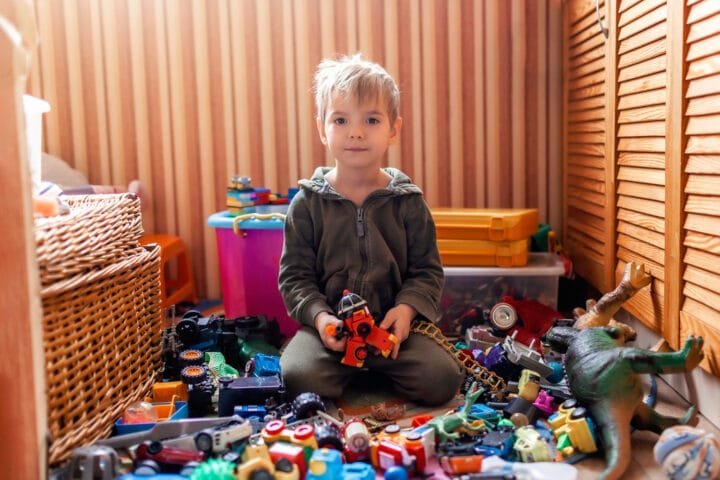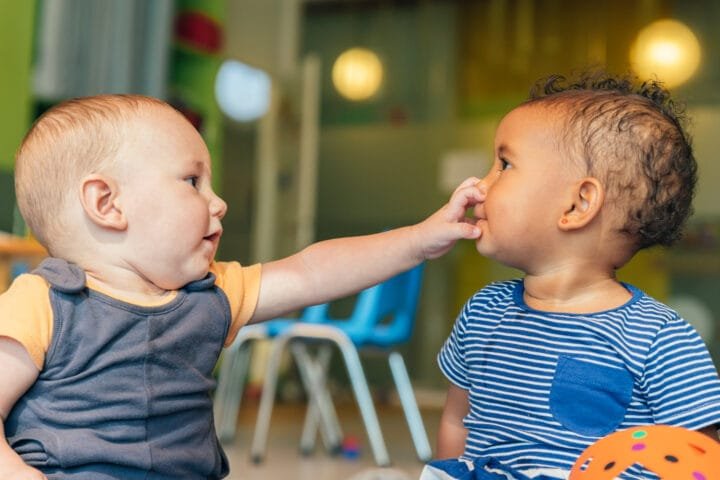Why Space Exploration Matters for Kids?
Remember those nights as a kid, lying on the grass, staring at the stars, and feeling mesmerized by their vastness? That sense of wonder, that insatiable curiosity about what lies beyond our tiny planet—most kids have it in spades. And guess what? Nurturing that fascination with space isn’t just a fun way to pass the time; it’s one of the most valuable things we can do for our kids’ development.
It’s like giving them a golden ticket to a universe of learning. This sparks a lifelong passion for discovery, setting them on the path to becoming tomorrow’s innovators, problem-solvers, and excellent humans. The joy of learning through space activities is something they’ll cherish, and you’ll be thrilled to witness.
Kids and the Cosmos: It’s a Love Story Written in the Stars
Kids are natural explorers. Their minds absorb new information and experiences like sponges soaking water from a black hole. And nothing captures children’s interest like space! Rockets blasting off into space, astronauts walking on the moon’s surface, aliens hiding out in distant galaxies—it all adds to childhood fantasies! You can encourage this curiosity by engaging your children in building model rockets, stargazing, or creating their homemade telescopes.
Think about it: when was the last time your kid asked you a question that stumped you? Kids are fearless about asking big questions, challenging assumptions, and imagining the impossible. And that’s precisely what we want to encourage, right?
“Somewhere, something incredible is waiting to be known,” wrote Carl Sagan. Those words perfectly capture the spirit of exploration we want to instil in our kids. When we encourage them to embrace space wonders, we’re not just teaching them about planets and stars; we’re fostering a sense of wonder, a love of learning, and a belief that anything is possible.
And hey, there’s some serious science to back this up! A 2018 study published in the journal Cognitive Development found that children engaged in space-themed play showed improved spatial reasoning skills, problem-solving abilities, and even better language development. Who knew pretending to be an astronaut could profoundly impact a child’s brain?
Space: The Ultimate STEM Learning Playground
Okay, let’s talk about STEM education for a minute. We all know it’s essential, but let’s face it: Sometimes, it can feel a bit dry. Textbooks, worksheets, and memorizing formulas are not the most exciting for kids (or parents).
But here’s the thing: space exploration is the ultimate playground for STEM learning. Forget about those dusty textbooks and abstract concepts. With space as your guide, you can transform learning into an adventure!
Imagine you and your kid are building a model rocket in the living room, laughing as you try to get the fins to stay put. But while you’re at it, you’re also explaining physics and engineering principles, like how thrust and gravity work together to launch that rocket sky-high. And don’t worry, we’re not suggesting sending your rocket into orbit! You can launch it in a safe, open area. Or you’re huddled over a homemade telescope, gazing at the moon’s craters and marveling at the vastness of the universe. And while you’re stargazing, you’re also delving into the science of optics. You’re learning how lenses and mirrors work together to bring distant celestial bodies into focus.
“Space exploration is a force for good,” says Dr. Mae Jemison, the first African American woman to travel to space. “It drives innovation, inspires us to dream more deeply, and reminds us of our interconnectedness with the universe.” And that force for the better extends far beyond science. When kids grapple with space-related challenges, they develop critical thinking skills, persevere through setbacks and cultivate a collaborative spirit.
The numbers don’t lie! A 2021 report by the National Academies of Sciences, Engineering, and Medicine found that students who participated in hands-on, inquiry-based space science activities showed a deeper understanding of scientific concepts and were more likely to pursue STEM careers. Building that rocket with your kid might be the first step toward a future career as an astronaut, engineer, or astrophysicist!
Raising Space-Savvy Kids: Why It Matters More Than Ever
Let’s be honest: our planet faces some significant challenges. Climate change, resource depletion, and global pandemics can feel daunting to us adults and make life more complicated than ever for the children around us. However, raising kids who can understand complex issues while engaging in informed discussions about their future is more essential than ever.
Space education cultivates scientific literacy. Satellites orbiting Earth provide data on deforestation, melting glaciers and rising sea levels, so why should space education be overlooked as an educational strategy? This information helps us understand the impact of human activities on our planet and make informed decisions about protecting our fragile ecosystem.
“We are part of this universe; we are in this universe, but perhaps more significant than both of those facts is that the universe is in us,” Carl Sagan famously wrote. That sense of interconnectedness, being part of something larger than us, motivates action. By fostering an understanding of our place in the cosmos, we empower our kids to become stewards of our planet. We also advocate for a sustainable future. This empowerment is what makes space education more critical than ever.
Let’s remember inspiration’s power. Space exploration has always driven innovation, pushing human ingenuity and technological advancement. By exposing our kids to space wonders, we’re not just expanding their knowledge; we’re igniting their imaginations and inspiring them to dream big. Who knows? Your children may design the first Martian colony, develop interstellar travel technology, or discover life beyond Earth! Innovation potential is something to be proud of and hopeful about.
Space Isn’t Just for Astronauts: It’s for All of Us
Space exploration might seem like this distant, unattainable realm reserved for astronauts and rocket scientists. But the truth is, it’s more accessible than you might think. Plenty of resources, from books to online platforms, can help you and your kids explore the cosmos from home. And the impact it has on our daily lives is mind-blowing.
I mean, think about it: the GPS we use to navigate, the satellite technology that lets us stream our favorite shows, even the weather forecast we check before heading out the door – all of these things have their roots in space research.
And here’s a fun fact: the average smartphone has more computing power than the Apollo 11 guidance computer that landed humans on the moon! That’s wild. This incredible technological leap is the direct result of space exploration investments. Miniaturization of electronics, advanced materials, and communication technology breakthroughs – spaceflight demands have driven all these.
Space exploration has extraordinary effects on the human understanding of Earth. Satellites orbiting above our planet offer us invaluable data about climate change, deforestation and natural disasters – helping us make informed decisions to preserve it for future generations and ensure sustainable futures for ourselves and future generations alike.
Making Space Cool for Every Kid: Breaking Down Barriers
Here’s the thing: every child, regardless of background, deserves the opportunity to reach for the stars. It doesn’t matter if they live in a large city or a small town, if they’re a math whiz or an artistic soul – space has something to offer everyone.
That means we need to break down access barriers, whether socioeconomic, geographical, or cultural. Libraries, museums, and community centers can be excellent resources, offering space-themed programs and activities for kids from all walks of life. And remember the incredible online resources from NASA and the Space Foundation. Seriously, there’s a whole universe of information waiting to be explored!
However, creating an inclusive culture extends far beyond providing resources. We must ensure all children see themselves reflected in space exploration stories. Furthermore, we should acknowledge and celebrate the contributions made by women, people of color, and individuals from diverse backgrounds. These contributions have played an essential part in furthering our understanding of space.
NASA astronaut Jessica Meir emphasizes that space education should include all kinds of people—not just a select few. Creating more inclusive classroom environments and encouraging diversity within space education programs can inspire an entire generation of explorers and innovators from every background.
Reaching for the Stars: A Parent’s Guide to Cosmic Adventures
How do we bring all this awesome stuff into our kids’ lives? Well, the good news is, it doesn’t take a rocket scientist (pun intended!). Here are some ideas to get you started:
- Turn your backyard into a mini observatory: Grab a blanket, a telescope (or even just a pair of binoculars!), and spend an evening stargazing with your kids. Download a stargazing app to identify constellations and planets. Share stories about the mythology behind constellations or make up your own!
- Blast off with some DIY rockets: Building and launching model rockets is a classic STEM activity that’s both thrilling and educational.
- Transform your living room into a planetarium: Grab a cardboard box, some string, and a few glow-in-the-dark stars, and create your mini planetarium. Project constellations onto the ceiling, tell stories about the planets, and let your kids’ imaginations soar!
- Cook cosmic treats: Bake moon-shaped cookies, decorate cupcakes with planets and stars, or make astronaut ice cream. Turn snack time into a fun and educational experience!
- Explore the world of space books and movies: There are tons of excellent space-themed books and films for kids of all ages. Curl up with an enjoyable book about the solar system. You can watch a documentary about the Apollo missions or have a family movie night with a space-themed classic like “Wall-E” or “Star Wars.”
- Plan a visit to a planetarium or science museum: Many planetariums and science museums provide interactive exhibits and shows designed to engage children. It’s an engaging way for them to discover space while learning from experts in their field.
- Embrace play: Encourage your kids to use their imaginations and create space adventures. Build a spaceship out of cardboard boxes, dress up as astronauts, and explore the backyard like an alien planet. Play is a powerful tool for learning and discovery!
Recommend Books
“National Geographic Little Kids First Big Book of Space” by Catherine D. Hughes:
This visually stunning book is perfect for young children. It features vibrant photographs, engaging illustrations, and simple explanations of complex concepts. The book covers everything from the solar system and stars to galaxies and space travel.
“The Magic School Bus Lost in the Solar System” by Joanna Cole:
Join Ms. Frizzle and her class on a wild ride through the solar system! This beloved book combines science and humor to teach kids about the planets, asteroids, and comets.
“Hidden Figures: The True Story of Four Black Women and the Space Race” by Margot Lee Shetterly:
This inspiring book tells the true story of four African American women who played a crucial role in the early days of NASA and the space race. It’s a powerful reminder that anyone can achieve their dreams, regardless of background.
“A Black Hole Is Not a Hole” by Carolyn Cinami DeCristofano:
This engaging book explains the mysteries of black holes in a way kids can understand. It uses vivid language and creative analogies to make complex scientific concepts accessible and fun.
“The Darkest Dark” by Chris Hadfield:
Written by a real-life astronaut, this heartwarming story follows a young boy who overcomes his fear of the dark to pursue his dream of space travel. It’s a beautiful reminder that even the biggest dreams are within reach.
Igniting a Lifelong Passion: Why It Matters
Look, I know life gets busy. Finding time for “extra” activities can be challenging between school, work, and all parenting demands. But trust me on this one: investing time in nurturing your child’s love of space is one of the most worthwhile things you can do.
Learning should move beyond memorizing facts and figures; instead, it should foster an environment of wonder, nurture exploration, and spark a passion for knowledge in our children. Our schools must equip young people with 21st-century skills like critical thinking, problem-solving, creativity, and collaboration. They must inspire them to dream big, strive towards excellence, and make an impression on society while reaching for the stars themselves.
So, the next time you gaze up at the stars with your child, remember you’re not just sharing a moment of wonder. You’re planting the seeds for a lifelong discovery journey. This journey may lead to new inventions, groundbreaking discoveries, and a deeper understanding of our place in the universe. Let’s reach for the stars together!
P.S. Share your space adventures with me! I’d love to hear about the creative ways you’re bringing the cosmos to life for your kids. And hey, if you stumble upon any excellent space-themed resources, send them my way! We’re all parenting together, and sharing is caring.
FAQs
Absolutely! Even toddlers can explore space. Begin with simple concepts like the sun and the moon. Read picture books about stars, sing songs about planets, and do some fun sensory activities like painting with “moon rocks” (aka playdough) or making craters in a “moon sand” sensory bin.
Turn learning into an adventure! Build a model rocket together, visit a planetarium, or create a mini “space station” in your living room with blankets and chairs. Bake some “moon cookies,” make constellation viewers, or have a “space-themed” movie night. The possibilities are endless!
NASA has a fantastic website for kids that provides games, activities, and information about space exploration. You can also find helpful books, apps, and websites dedicated to astronomy for children. Check out your local library or museum for more resources.
Are they interested in space travel and astronauts? Wonderful! Promote their curiosity by providing books and documentaries about them, visiting space centers or museums, STEM camps or programs, and encouraging their dreams by nurturing their curiosity! Most importantly, stimulate their imagination and ensure their dreams become attainable goals!
Space exploration sparks curiosity promotes critical thinking skills and sparks dreams. It is an entryway to STEM learning – developing children’s love of science, technology, engineering and math (STEM). Furthermore, it helps children understand our place in the universe while appreciating its fragility.
Related Posts
















































































